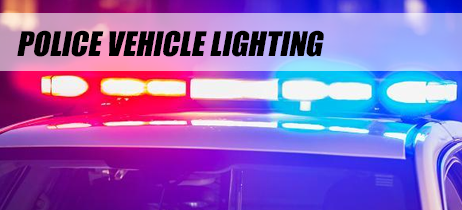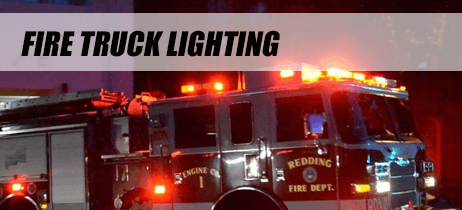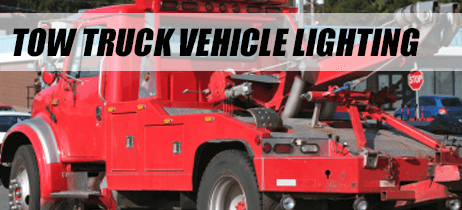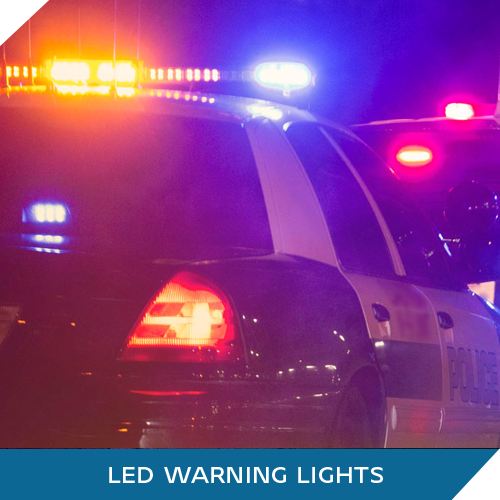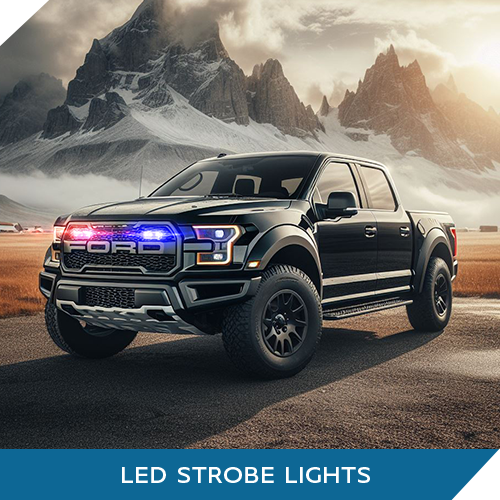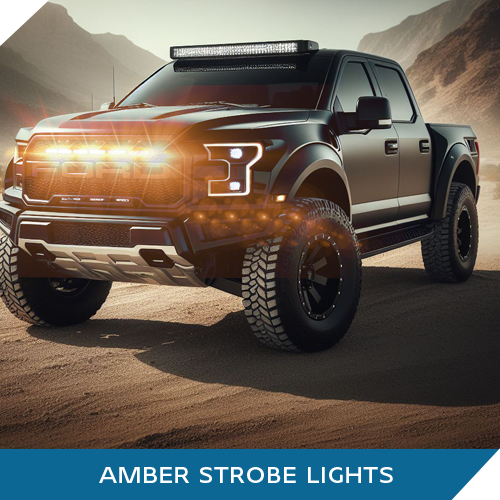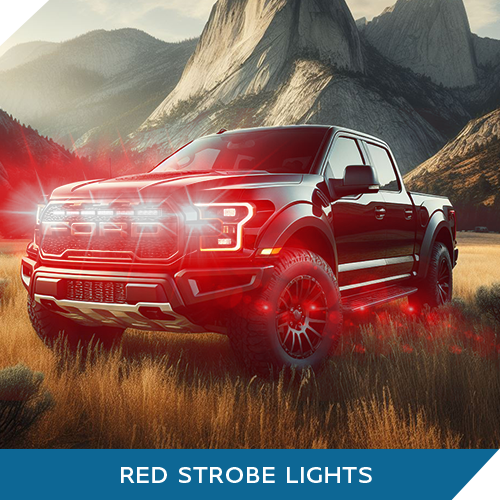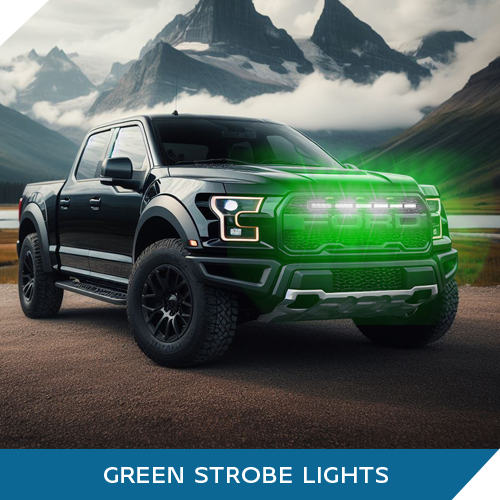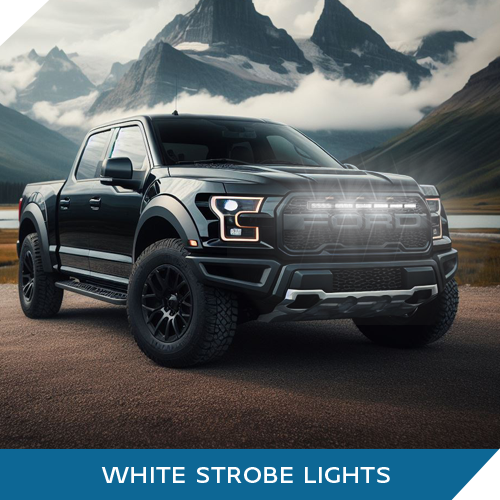LED Emergency Vehicle Lights
Shop by LED Emergency Vehicle Lights Category
LED Emergency Vehicle Lights By Industry
By Product Category, Industry and Profession and Vehicle Type
By Product Category
Dash Lights: Specifically designed for interior front window placement, dash lights offer essential visibility for unmarked vehicles in covert operations. These lights provide intense illumination without compromising the driver's view, making them suitable for both day and night operations in urban and rural settings. Their discreet presence makes them a favorite among undercover law enforcement and private security firms.
Visor Lights: Ideal for undercover and plainclothes vehicles, visor lights offer a blend of stealth and performance. They attach directly to the vehicle's sun visor, providing immediate emergency lighting without external installation. This makes them easy to activate and highly effective for maintaining the element of surprise in critical situations.
Mini Light Bars: Offering a balance between size and power, mini light bars are perfect for various emergency vehicles, including unmarked cars and smaller response units. They provide significant visibility with a lower profile, making them versatile for multiple scenarios without overwhelming the vehicle's aesthetic.
Full-Size Light Bars: The most comprehensive solution for emergency lighting, full-size light bars deliver unmatched 360-degree visibility. Essential for ambulances, fire engines, and patrol cars, they feature a range of patterns and colors to signify different emergency statuses and commands, ensuring clear communication to all nearby.
Surface Mount Lights / Grille Lights: Engineered for exterior durability, these lights are designed to withstand harsh conditions while providing critical visibility. Mounted on grilles, bumpers, or any flat surface, they're adaptable to any vehicle type, enhancing safety and presence on the road.
Hideaway Lights: Uniquely designed for covert operations, hideaway lights fit into existing vehicle light casings, preserving the vehicle's nondescript appearance until activated. Ideal for unmarked emergency vehicles, they provide a sudden burst of light when needed, ensuring element of surprise and safety.
Stick Lights: Long and narrow, stick lights offer extended visibility and can be mounted inside or outside the vehicle. They are particularly useful for marking the vehicle's sides, improving visibility during broad daylight and at night, aiding in safer passage through traffic.
By Industry and Profession
Police Vehicles: Emergency lights for police vehicles are crucial for maintaining law and order. They provide the necessary visibility for patrol cars during night shifts and ensure quick, safe passage during high-speed pursuits. Specialized lighting, such as flashing blues, serves as a universal signal, commanding attention and respect while enhancing officer safety during traffic stops and emergency responses.
Firefighter Truck: Firefighting units require robust and highly visible emergency lights to navigate through traffic and signal urgency to civilians. These lights, often in vibrant reds and whites, are designed to withstand extreme conditions, ensuring that firefighters can arrive at scenes quickly and safely, providing critical illumination for rescue operations and scene security.
EMS: Ambulances and EMS vehicles use distinct emergency lighting to alert the public and clear paths through congested areas swiftly. The lighting must be unmistakable and reliable, aiding in rapid response to medical emergencies where every second counts, ensuring the safety of both the patients and the medical team.
Construction Trucks: In construction areas, safety and visibility are paramount. Emergency lights are used on vehicles to signal active work zones, protecting workers and passersby. The lighting solutions for this industry are built to endure rugged conditions, enhancing visibility day and night to prevent accidents and ensure safe operations.
Heavy Duty Equipment: Heavy machinery and equipment used in mining, logging, and other heavy-duty applications require strong, clear lighting for safety and operational efficiency. These lights ensure that large vehicles are visible in all conditions, reducing the risk of accidents in hazardous environments.
Tow Trucks: Tow trucks operate in various environments and times, often during low visibility conditions. Emergency lighting is critical for signaling their presence to other drivers, protecting both the tow operators and the public during vehicle recovery and roadside assistance.
Security Vehicles: For security vehicles, discreet yet effective lighting is essential. These lights enhance the presence of patrol cars, deterring criminal activity and ensuring quick response times during incidents, providing safety and reassurance to the community.
Pilot-Escort Vehicles: Vehicles escorting oversized loads rely on emergency lights to guide their convoy and warn other road users. The lighting ensures the safety of the escort journey, alerting oncoming traffic to potential road obstructions or changes in traffic patterns.
Public Utility Trucks: Utility vehicles, often responding to outages and emergencies, need clear, visible lighting for both day and night operations. These lights help ensure worker safety, especially during repairs in adverse weather conditions or in the midst of traffic.
Public Works Trucks: Vehicles in the public works sector use emergency lighting to enhance safety during infrastructure maintenance and emergency responses. The lighting aids in visibility, ensuring that public services can be carried out efficiently and safely, regardless of the time or weather conditions.
Each industry requires tailored emergency lighting solutions to meet unique operational and safety challenges, ensuring that all service vehicles are equipped to handle their critical roles effectively.
By Vehicle Type
Cars: Emergency lights designed for cars are tailored for unobtrusive integration and swift activation, crucial for undercover police operations or high-urgency response teams. They are crafted to blend seamlessly when inactive, yet provide powerful, unmistakable signaling when in action, balancing discretion with safety.
Trucks: In the context of larger vehicles like trucks, emergency lights must contend with greater heights and visibility challenges. These lights are engineered to project their signals over longer distances and wider areas, ensuring that their warning reach compensates for the vehicle's size, crucial for construction zones or accident sites.
SUVs: SUV emergency lights combine the discreet form factor needed for undercover work with the robust intensity required for all-terrain responses. Ideal for both urban law enforcement and rural rescue missions, these lights are versatile, providing clear signaling in congested cityscapes or remote locations.
Specialty Vehicles: Lights for specialty vehicles, such as hazardous materials units or mobile command centers, require custom solutions that cater to specific operational needs. These might include higher-intensity beams, various light patterns, or integration with other vehicle warning systems, ensuring they meet the unique demands of specialized tasks.
Motorcycles: Due to their size and speed, emergency lights for motorcycles are designed for maximum visibility without impacting maneuverability. They offer rapid response units a balance of lightweight construction and high-visibility output, essential for navigating through traffic quickly and safely during emergencies.
Off-Road Vehicles: For vehicles operating in off-road conditions, emergency lights are built to withstand rugged environments while providing substantial visibility. These are essential for search and rescue operations in remote areas, ensuring teams are visible even in poor weather or challenging terrains.
By Emergency Vehicle Lights Features
Flash Patterns
Comet Flash: This pattern creates a dynamic, trailing effect, where lights illuminate in succession, giving the impression of movement. The Comet Flash is ideal for signaling rapid direction changes or for drawing focused attention to specific actions the emergency vehicle is taking, enhancing clarity and response from surrounding traffic.
Pulsar Burst: This pattern replicates the pulsating rhythm of a pulsar star, delivering bursts of light with pauses in between. It's particularly effective in situations where a strong, noticeable alert is needed but with a less aggressive approach than continuous strobing, making it suitable for urban environments where pedestrian traffic is high.
S.O.S. Pattern: Dedicated to the most critical emergencies, this pattern flashes in the universal distress signal sequence, communicating immediate need for assistance. Reserved for dire situations, it sends a clear message to all who see it, ensuring that the emergency vehicle's call for help is understood universally.
Continuous Cycle: A versatile pattern that cycles through various flash sequences, offering a dynamic approach to maintain attention over extended periods. It's particularly useful during long-duration incidents or complex operations, providing continuous alert without desensitization.
Hybrid Mode: Integrates various elements from different patterns to create a comprehensive signal tailored to specific operational needs. This adaptive approach allows for customized signaling, ensuring that the emergency vehicle can communicate effectively in a wide range of scenarios and conditions.
Pulsar Burst: The Pulsar Burst pattern offers a sequence reminiscent of the universe's natural rhythms, designed for scenarios requiring standout visibility. With bursts that mirror celestial pulsars, this pattern is utilized to signify high-priority emergencies, ensuring the vehicle is noticed even amidst bustling city lights or rural darkness, enhancing reaction time from surrounding traffic.
Continuous Cycle: This pattern offers a dynamic array of flashes, cycling through various modes to avoid blending into the ambient lighting. Ideal for prolonged incidents, the Continuous Cycle keeps the emergency vehicle conspicuously visible over time, maintaining public awareness and ensuring ongoing safety around the scene.
Hybrid Mode: The Hybrid Mode combines elements from different flash patterns to create a versatile signaling system. Tailored to specific operational needs, this adaptive pattern allows emergency responders to communicate distinct messages depending on the situation, offering flexibility and clear communication in diverse emergency contexts.
Fading Glow: This flash pattern is akin to a gentle heartbeat, with lights that gradually brighten and then fade. It's often used in situations requiring a subdued yet noticeable warning signal, ideal for environments where traditional flashing might be disruptive or needlessly alarming.
Oscillating Beam: Mimicking the motion of a lighthouse beam, this pattern sweeps light across a broad area, providing excellent visibility and ensuring the emergency vehicle's presence is noted from all angles, particularly useful in dense fog or heavy rain.
Double Flash: This pattern features two quick flashes in succession, providing a balanced signal that's easily noticed but not overly startling, suitable for both urban patrols and highway responses, where clarity and distinction are key.
Simulated Rotating: Offering the traditional appearance of a rotating light with modern LED efficiency, this pattern is designed for those who prefer the classic look but require the performance of contemporary technology.
Beacon Burst: Like a lighthouse warning ships at sea, this pattern shines a powerful beam at regular intervals, excellent for marking stationary vehicles or highlighting large emergency scenes from a distance.
Arrow Signal: Directing traffic around or towards emergency scenes, this pattern uses sequential flashing lights to form an arrow, guiding drivers away from hazards or towards detours, essential for accident scenes or roadblock situations.
Random Flash: Designed to prevent habituation, this pattern varies unpredictably, ensuring that the emergency lights remain noticeable even during prolonged incidents, keeping bystanders and passing traffic alert.
Sweep and Scan: This pattern creates a moving light that scans back and forth, providing wide-area visibility and drawing attention to the vehicle's location, particularly effective for scene safety and during search operations.
Comet Flash: Creating a captivating streak effect, this pattern is used to draw significant attention in parades or large public events where emergency vehicles are part of a procession but need to maintain a level of alert.
Pulsar Burst: Mimicking the rhythmic pulsing of a star, this flash pattern is used during extreme emergencies, providing a distinct and noticeable alert to all nearby, signaling the need for immediate attention and action.
Continuous Cycle: Cycling through various patterns, this setting ensures that the emergency lighting remains dynamic and engaging, reducing the chance of it blending into the background, especially during lengthy operations.
Hybrid Mode: This pattern allows for customization and adaptation to the situation at hand, combining elements from multiple patterns to create a comprehensive alert system tailored to specific emergency scenarios.
By Color
Red Emergency Vehicle Lights: Commonly seen on fire trucks and ambulances, red lights are the universal signal for emergencies necessitating immediate action. This color not only demands urgency but is deeply ingrained in public consciousness as the beacon of lifesaving activities. Innovations in lighting technology have made these red lights more potent, ensuring they penetrate through adverse weather conditions, enhancing the safety and efficiency of emergency responses.
Blue Emergency Vehicle Lights: The hallmark of law enforcement, blue emergency lights are critical in signaling police presence and authority. With advancements such as variable flash patterns and intensities, blue lights are tailored to different operational needs—from high-speed chases to managing public events—ensuring officers can maintain public safety and order effectively.
Amber Emergency Vehicle Lights: Amber lights are vital for vehicles in construction, utility, and roadside assistance, serving as a visual cue for caution to the surrounding traffic. The evolution of amber lighting includes integration with traffic management systems to safely guide pedestrians and vehicles around hazards, significantly enhancing operational safety and public awareness.
White Emergency Vehicle Lights: Beyond mere illumination, white emergency lights have been refined for various uses across service industries, combining with other colors to improve visibility and communication. These lights now come equipped with features like directional beams and adjustable intensity, making them indispensable for night operations and low-visibility conditions.
Green Emergency Vehicle Lights: Typically utilized by volunteer emergency services and command vehicles, green lights signify a distinct operational role. Recent trends see green lights used more in community and private emergency services, enhancing their visibility and distinguishing them from traditional emergency vehicles, thus fostering better community response and interaction.
Amber White Emergency Vehicle Lights: The Amber White color scheme plays a pivotal role in enhancing the safety and visibility of utility and service vehicles, especially in challenging conditions. Recognized universally, the amber color signals caution, a necessary attribute when navigating through busy streets, construction zones, or areas of maintenance. When combined with white, the visibility of these vehicles improves significantly both during the day and at night. This is crucial in maintaining public safety and ensuring that service vehicles can perform their duties without unnecessary hindrance. By employing this color combination, vehicles used in construction, roadside assistance, and maintenance can communicate effectively with the surrounding traffic, ensuring smooth operation in various environmental conditions.
Red White Emergency Vehicle Lights: The Red White combination is a classic yet powerful color pairing used extensively across emergency service vehicles. The urgency signified by the red color is well-known, denoting immediate attention and action, which is essential for ambulances and fire trucks responding to emergencies. Paired with white, the color scheme cuts through the darkness and fog, providing excellent visibility and clarity, crucial during night-time operations or in obscured weather conditions. This blend not only serves as a beacon of emergencies but also significantly aids in illuminating the surroundings, thereby ensuring that emergency responders can work efficiently and safely.
Red Blue Emergency Vehicle Lights: Synonymous with law enforcement, the Red Blue combination is meticulously designed to denote authority while signaling urgency. This color pairing commands attention and communicates a clear message of emergency, prompting civilians to yield and allowing officers to respond swiftly. The distinct contrast between red and blue ensures that these vehicles are visible under any circumstances - day or night, rain or shine. This is essential for effective law enforcement operations, from high-speed pursuits to managing public safety during significant events or incidents.
Green Amber Emergency Vehicle Lights: Specialized Signaling for Service Vehicles. The Green Amber combination is reserved for vehicles that perform specialized services, such as those related to environmental or municipal functions. Green communicates a sense of command or utility presence, which, when paired with amber, guides the public response with a hint of caution. This combination is particularly beneficial for vehicles that operate in less conventional roles but still require clear identification and respect on the roads, such as street cleaning, park services, or during environmental emergencies. This distinctive color pairing ensures these vehicles stand out, minimizing confusion and enhancing overall safety.
Red Amber Emergency Vehicle Lights: The blend of Red and Amber is a strategic choice for vehicles engaged in complex emergency scenarios. This color combination signals a high degree of urgency while also prompting caution among the public, an essential balance in multifaceted response situations. Whether navigating urban thoroughfares or rural paths, the Red Amber lights ensure that emergency vehicles are noticed and given the space and respect needed to operate effectively. This versatility makes the Red Amber combination a critical tool in the emergency services' visual communication arsenal.
Blue Amber Emergency Vehicle Lights: The Blue Amber pairing is designed for scenarios that necessitate a display of authority while simultaneously signaling caution. This combination is particularly effective for vehicles involved in roadside emergencies or those used by security personnel. The blue color asserts authority, alerting onlookers to the presence of an official vehicle, while amber advises caution, encouraging drivers to slow down and be alert. This balance is crucial for maintaining safety and order during traffic stops, accident responses, or security operations.
Green White Emergency Vehicle Lights: The Green White color scheme is primarily used by command vehicles or certain medical units to ensure they are immediately identifiable amidst a sea of emergency services. The green color typically represents safety or medical assistance, signaling to the public that help or authority is on-site. When combined with white, this pairing not only enhances visibility but also aids in scene illumination, which is crucial during operations that require a high level of clarity and distinction from other emergency services.
Each of these colors plays a vital role in emergency communication and vehicle identification, adhering to regulatory standards and public expectations for safety and response efficiency.
Mounting Locations for Emergency Vehicle Lights
Roof Mounts: Ensuring Maximum Visibility The roof of an emergency vehicle serves as the prime location for mounting light bars, ensuring they are visible from all angles, even at great distances. This elevated position allows for 360-degree visibility, crucial for clear communication in all directions. Roof-mounted lights are particularly beneficial in heavy traffic conditions, as they remain visible over other vehicles, ensuring that emergency responders can move quickly and safely. Typically, these are used in combination with other lighting systems to provide comprehensive coverage, essential for police cars, fire trucks, and ambulances during emergency responses.
Grille and Bumper Mounts: Grille and bumper mounts offer direct, forward-facing visibility, making them indispensable for clear signaling ahead of the vehicle. These mounting locations are ideal for initiating immediate responses from traffic ahead, as they are at eye level for most drivers. Grille lights, in particular, can be integrated seamlessly into the vehicle's design, providing a discreet yet powerful lighting solution. Bumper-mounted lights, on the other hand, are lower to the ground, enhancing visibility in foggy or smoky conditions, crucial for advancing safety and visibility in adverse weather.
Side-Mounted Lights: Enhancing Lateral Visibility Side-mounted lights are essential for intersections and crossing scenarios where lateral visibility is crucial. Mounted on the sides of the vehicle, these lights provide a clear signal to pedestrians and vehicles approaching from the side. This is particularly important for emergency vehicles that need to navigate through cross traffic or are stationary at a scene. Side-mounted lights help in delineating the vehicle's presence and movements, significantly reducing the risk of side collisions and ensuring safer passage through crowded areas.
Rear and Tail Light Mounts: Signaling Intentions Clearly Rear and tail light mounts are critical for communicating the emergency vehicle's intentions to following traffic. These lights, mounted at the rear of the vehicle, can be used to signal stopping, turning, or reversing, providing clear instructions to other road users. This is particularly important in high-speed or high-traffic situations where sudden stops or turns can lead to accidents. Rear-mounted lights ensure that vehicles following behind are aware of the emergency vehicle's actions, enhancing overall road safety.
Mirror and Visor Mounts: Unobstructed Signaling Mirror and visor mounts provide an excellent solution for additional forward-facing visibility without obstructing the driver's view. Mounted on side mirrors or the vehicle's visor, these lights offer an unobstructed line of sight to oncoming traffic and pedestrians. They are particularly useful for unmarked emergency vehicles or as a supplementary lighting system, providing visibility while maintaining the vehicle's discreet appearance. These lights are crucial for undercover operations or when minimal visual disruption is desired.
Interior Window Mounts: Versatile and Discreet Interior window mounts are used for lights placed inside the vehicle, usually attached to the windshield, rear window, or side windows. This mounting option provides a balance between visibility and discretion, allowing for clear signaling without altering the vehicle's exterior. Interior-mounted lights are particularly useful for unmarked vehicles or for additional lighting in marked emergency vehicles. They offer a level of versatility and discretion, making them suitable for a variety of scenarios, from covert operations to routine patrols.
Fender Mounts: Side and Angle Visibility Fender-mounted lights provide an additional angle of visibility, particularly beneficial for situations where side visibility is critical, such as navigating through tight spaces or crowded streets. These lights are positioned on the fender, just above the wheels, making them visible at an angle where other lights might be obscured by obstacles. They are especially useful for motorcycles, smaller emergency vehicles, or as supplementary lighting on larger vehicles to enhance side visibility.
License Plate Mounts: Integrated Rear Visibility License plate lights are a discreet yet effective way to enhance rear visibility without significant modifications to the vehicle. These lights are mounted around the license plate area, providing illumination and signaling capabilities without obstructing the plate itself. This mounting location is particularly useful for unmarked vehicles or for adding additional visibility to the rear of any emergency vehicle.
Hood and Trunk Mounts: Elevated and Direct Visibility Hood and trunk-mounted lights offer unique positioning for emergency lighting. Hood-mounted lights, positioned at the front of the vehicle, provide elevated visibility that complements the main light bar or grille lights. Trunk-mounted lights, on the other hand, are effective on sedans or SUVs, offering elevated rear visibility, especially when the vehicle's trunk is open, which can obscure other rear-mounted lights.
Running Board and Step Mounts: Lower Lateral Visibility Lights mounted on the running boards or steps of a vehicle provide lower lateral visibility, which is particularly useful for large vehicles like fire trucks or utility vehicles. These lights help illuminate the vehicle's sides at ground level, improving visibility for pedestrians and vehicles approaching from the side, especially in low-light conditions.
Push Bumper Mounts: Mounted directly onto the push bumper of a vehicle, these lights add frontal visibility and are particularly useful for clearing traffic or signaling during pursuits. Push bumpers are commonly found on police vehicles, and the added lights can make them more noticeable when navigating through congested areas.
Back Rack or Headache Rack Mounts: For trucks and utility vehicles, lights can be mounted on back racks or headache racks (protective barriers mounted behind the cab). This placement provides elevated visibility from the back and sides of the vehicle, which is particularly useful for vehicles that spend a lot of time stationary at worksites or during roadside emergencies.
Toolbox or Storage Box Mounts: On utility vehicles, emergency lights can be mounted on toolboxes or storage boxes. This provides additional side and rear visibility, particularly for vehicles used in construction.
Corner Strobe Lights: These are mounted at the corners of the vehicle to enhance visibility when the vehicle is approaching intersections or when navigating through heavy traffic. They provide additional angles of visibility, complementing the primary light bars and other mounted lights.
Sun Visor Mounts: Unlike dashboard or windshield-mounted lights, sun visor mounts attach directly to the vehicle's sun visors. This can provide an alternative interior mounting location that is less obtrusive to the driver's view while still offering significant forward-facing visibility.
Pillar Mounts: Some emergency vehicles utilize the A, B, or C pillars (the vertical structures supporting the windshield, doors, and rear window) as mounting points for additional lighting. This can provide enhanced side visibility and is particularly useful for illuminating the vehicle's flanks during crossings or when working alongside the road.
Compliance, Certification, and Regulation for Emergency Vehicle Lights
Requirements
Visibility and Intensity Standards: For emergency vehicle lights, adherence to visibility and intensity standards is crucial. These standards ensure that lights are sufficiently bright and visible under all operational conditions, enhancing the safety of both the emergency responders and the general public. Compliance with these standards is not just about legal obligation but about ensuring the efficacy of emergency responses.
Color Compliance: The use of specific color codes for emergency vehicle lights is regulated to ensure immediate recognition and appropriate response from the public. Red and blue lights are traditionally reserved for police and fire services, while amber lights denote utility or construction vehicles. Adhering to these color codes is vital for maintaining operational clarity and safety.
Flashing Pattern Regulations: The deployment of specific flashing patterns is regulated to convey different urgencies and messages. For instance, certain patterns may be designated for stopping traffic, while others indicate general caution. Compliance with these regulations ensures that emergency signals are universally understood, preventing confusion and potential accidents.
Mounting Requirements: Regulations often dictate the acceptable mounting positions and methods for emergency lights, ensuring optimal visibility and safety. These requirements take into account factors like the height, angle, and position of lights on the vehicle, ensuring that they are effective without impeding the driver's visibility or vehicle operation.
Compliance
Adherence to State Statutes: Compliance with state-specific statutes governing the use of emergency vehicle lights is essential. These statutes detail the legal requirements for different types of emergency and service vehicles, including permissible colors, flashing patterns, and usage scenarios. For comprehensive guidelines, refer to the Extreme Tactical Dynamics State Statutes guide [here].
Operational Compliance: Ensuring operational compliance involves the correct usage of emergency vehicle lights, including when and how they can be activated. This is crucial for maintaining the effectiveness of emergency signaling and ensuring public safety during emergency responses or roadside operations.
Certification
Industry Certifications: Obtaining industry certifications such as those from the Society of Automotive Engineers (SAE) or the International Electrotechnical Commission (IEC) signifies that emergency vehicle lights meet established standards for performance and safety. These certifications are a testament to the reliability and effectiveness of the lighting solutions.
Regulation
Federal and International Standards: Compliance with both federal and international standards ensures that emergency vehicle lights are suitable for use in a wide range of jurisdictions and operational contexts. These standards set the baseline for safety and performance, providing a framework for uniformity and recognition across borders.
Industry Standards and Compliance
Weather Resistance and Durability: Adhering to industry standards for weather resistance and durability ensures that emergency vehicle lights can withstand harsh environmental conditions, from extreme temperatures to heavy rain and snow. This resilience is key to maintaining visibility and functionality when it's needed most.
Electromagnetic Compatibility (EMC): Compliance with EMC standards is crucial to prevent interference with other electronic systems in the vehicle or surrounding environment. This ensures that emergency lights operate harmoniously within the technological ecosystem of modern emergency and service vehicles.
Innovations in LED Technology: Staying abreast of innovations in LED technology and integrating these advancements into emergency lighting solutions ensures compliance with evolving standards for energy efficiency, brightness, and operational lifespan. This ongoing innovation supports sustainable practices and enhances the overall performance of emergency lighting systems.
User Safety and Environmental Considerations: Compliance with standards addressing user safety and environmental impact reflects a commitment to responsible manufacturing and usage. This includes minimizing light pollution, ensuring that materials and components are safe and environmentally friendly, and promoting energy-efficient operations.
By adhering to these guidelines for compliance, certification, and regulation, emergency vehicle lighting solutions from Extreme Tactical Dynamics stand as benchmarks for quality, safety, and effectiveness. Our commitment to meeting and exceeding these standards underscores our dedication to supporting the vital work of emergency responders and service professionals with reliable, high-performance lighting solutions.
Safety Tips and Maintenance for Emergency Vehicle Lights
Installation Guidelines
The proper installation of emergency vehicle lights is pivotal not just for the functionality of the lights but also for the safety of the vehicle and its occupants. Firstly, it is essential to ensure that the installation of any lighting system is compliant with both the manufacturer's specifications and local regulatory standards. This includes considering the placement of lights to maximize visibility and effectiveness without obstructing the driver's view or vehicle operation. Additionally, wiring should be professionally handled to prevent electrical issues, ensuring that connections are secure and that the system is integrated correctly with the vehicle’s power supply. It's advisable to have installations performed or inspected by qualified professionals to guarantee that the system operates as intended, adhering to all safety and legal requirements.
Operation Guidelines
Understanding and following proper operation guidelines for emergency vehicle lights are crucial to ensure they are used effectively and safely. Operators should be familiar with the function and control of their lighting systems, including how to activate different light patterns and intensities based on specific situations. It’s important to use emergency lights responsibly, activating them only when necessary to avoid desensitizing the public to their importance. Regular training and refreshers can help operators stay updated on best practices and regulatory changes, ensuring the lights are used efficiently, responsibly, and safely during all emergency and service operations.
Safety Procedures
Safety procedures surrounding the use of emergency vehicle lights are designed to protect both the operators and the general public. This includes conducting pre-operation checks to ensure all lights are functioning correctly before embarking on a call. Additionally, while emergency lights serve as a critical tool for signaling urgency and right-of-way, they do not exempt drivers from practicing safe driving habits. Operators must use emergency lights in conjunction with sound judgment, adhering to road safety laws and considering the conditions of their environment to minimize risks. Training on safety procedures should also cover the correct response if lighting systems malfunction while in operation, ensuring drivers can handle such situations calmly and safely.
Regular Maintenance and Inspection
Consistent maintenance and routine inspections are key to ensuring the long-term functionality and safety of emergency vehicle lights. Schedule regular check-ups to identify and address potential issues such as dimming lights, damaged fixtures, or wiring problems. A well-maintained lighting system is less likely to fail during critical moments, ensuring reliable performance when it matters most. Maintenance logs should be kept to track the history of inspections and repairs, facilitating proactive upkeep and replacements as needed.
Understanding and Adapting to Environmental Conditions
Operators should be aware of how different environmental conditions affect the operation and visibility of emergency lights. For instance, fog, heavy rain, or bright sunlight can impact how well lights are seen by other road users. Adjusting the intensity or flash patterns based on the environment can enhance visibility and safety. Training should include guidelines on how to best utilize lights under varying conditions, ensuring optimal effectiveness regardless of the weather or time of day.
Emergency Protocols for Lighting Failure
Having protocols in place for lighting failures is essential for maintaining safety during emergency responses. Operators should know immediate steps to take if lights fail, such as using alternative signaling devices or adjusting operational tactics to ensure safety until the issue can be addressed. Regular drills and training on emergency protocols can prepare teams for such eventualities, minimizing risks and maintaining operational integrity.
Warranty, Product Lifecycle, and Troubleshooting for Emergency Vehicle Lights
Warranty
Comprehensive Coverage: Our warranty policy is designed with our customers' needs in mind, offering comprehensive coverage that reflects our confidence in the quality and reliability of our emergency vehicle lights. This warranty covers defects in materials and workmanship for a specified period, ensuring that any issues encountered during normal use are addressed promptly and effectively, without additional cost to our customers.
Easy Claim Process: We strive to make the warranty claim process as straightforward and hassle-free as possible. Customers can initiate a claim through various channels, and our dedicated support team is committed to resolving issues swiftly, ensuring minimal downtime for your essential services.
Reliability and Affordability
Balancing Quality with Cost: At the heart of our mission is the commitment to offer reliable, high-quality emergency vehicle lights at an affordable price. We achieve this balance by employing advanced manufacturing techniques, rigorous quality control measures, and efficient supply chain management, ensuring our customers receive the best value without compromising on quality.
Durability
Built to Last: Our emergency vehicle lights are engineered for durability, utilizing high-quality materials and state-of-the-art technology to withstand the rigors of daily use in various environments. This commitment to durability ensures that our lights deliver consistent performance, reducing the need for frequent replacements and maintenance.
Weather Resistance
All-Weather Performance: Designed to perform in all weather conditions, our lights feature weather-resistant housing and seals, ensuring they remain operational and visible whether in rain, snow, heat, or cold. This resilience guarantees that first responders and service vehicles can rely on their lighting systems in any situation.
Regular Inspections
Ensuring Optimal Performance: To maintain the effectiveness and reliability of emergency vehicle lights, regular inspections are crucial. These inspections should focus on assessing the physical condition of the lights, checking for any signs of wear or damage, and ensuring all components function as expected.
Checking and Testing
Verifying Functionality: Beyond physical inspections, checking and testing the lights for proper operation are essential steps in maintenance. This includes verifying that all light patterns function correctly, the intensity of the lights meets specifications, and the lights respond as expected to controls.
Cleaning and Care
Maintaining Visibility: Regular cleaning is vital to ensure that emergency vehicle lights maintain optimal visibility. Dirt, dust, and other residues can diminish the effectiveness of the lights, so it’s important to clean them regularly with appropriate cleaning solutions and materials to prevent damage.
Addressing Technical Issues
Troubleshooting Common Problems: Encountering technical issues with emergency vehicle lights can be challenging, but many common problems can be resolved with basic troubleshooting. This might include checking power connections, ensuring control systems are properly configured, and replacing any defective components.
Professional Support for Complex Issues: For more complex technical issues that cannot be resolved through basic troubleshooting, professional support is available. Our team of experts can assist with diagnosing problems, providing repair or replacement services, and offering guidance to prevent future issues.
Product Lifecycle
From Design to Decommission: Understanding the lifecycle of emergency vehicle lights—from initial design and manufacture through to regular use, maintenance, and eventual decommissioning—is key to maximizing their value and effectiveness. We support our customers at every stage of this lifecycle, providing guidance on installation, use, maintenance, and when it's time to upgrade to newer technology.
Regular Maintenance for Longevity: Implementing a regular maintenance schedule is critical to extending the lifespan of emergency vehicle lights. This includes routine inspections, cleaning, and immediate addressing of any technical issues that arise, ensuring the lights continue to perform reliably over time.
FAQ Section for Emergency Vehicle Lights
What types of emergency vehicle lights are most effective for visibility in both day and night conditions?
The effectiveness of emergency vehicle lights in both day and night conditions largely depends on the type of light used and its design features. LED (Light Emitting Diode) lights are widely regarded as the most effective option due to their high brightness levels and low power consumption. LEDs provide intense illumination that can penetrate daylight brightness and stand out clearly in the dark, making them ideal for 24/7 operational needs of emergency vehicles. The versatility of LEDs allows for a range of colors and flashing patterns, which can be easily seen from long distances and different angles, ensuring maximum visibility and safety for emergency responders and the public.
Moreover, the design of the light, including the placement on the vehicle and the ability to produce various flash patterns, plays a crucial role in visibility. Full-size light bars mounted on the roof offer 360-degree visibility, which is essential for situations where an emergency vehicle needs to be visible from all sides. For specific applications, directional lights, such as dash lights, grille lights, or side-mounted lights, provide focused visibility that can alert oncoming traffic or pedestrians effectively. The combination of LED technology and strategic light placement enhances the overall effectiveness of emergency vehicle lights in all conditions.
How often should emergency vehicle lights be tested and maintained?
Emergency vehicle lights should be tested and maintained regularly to ensure they are always in optimal working condition. Ideally, a routine check should be performed at the start of each shift or at least once a week, depending on the frequency of use and the operational environment. These checks should include testing all light functions, verifying the clarity and intensity of the illumination, and ensuring that all flashing patterns operate as intended. Regular maintenance not only ensures the reliability of the lights during emergency responses but also extends their lifespan by identifying and addressing issues early on.
In addition to routine checks, a more thorough inspection and maintenance schedule should be established on a monthly or quarterly basis. This comprehensive maintenance should involve cleaning the lights to remove any dirt, debris, or residue that could impair visibility, checking for any physical damage to the light units or mounts, and inspecting electrical connections for signs of wear or corrosion. Proactive maintenance is crucial for preventing failures in critical moments and maintaining the safety and efficiency of emergency response operations.
Are there legal requirements for the use of emergency vehicle lights?
Yes, there are specific legal requirements and regulations governing the use of emergency vehicle lights, which vary by jurisdiction and the type of emergency service. These laws detail which vehicles are authorized to use emergency lights, the colors of lights that can be used, and when and how the lights should be activated. For example, police vehicles, ambulances, and fire trucks are typically allowed to use blue and red lights, which signify an immediate emergency, while vehicles like tow trucks and construction vehicles may use amber lights to indicate caution.
It is essential for emergency vehicle operators and fleet managers to be familiar with and adhere to these legal requirements to ensure compliance and avoid penalties. Regulations are designed to ensure that the use of emergency lights is consistent, recognizable, and effective in signaling emergencies to the public. For detailed information on state-specific statutes and regulations, it is advisable to consult the Extreme Tactical Dynamics State Statutes guide and local DMV regulations. Staying informed and compliant with these legal standards is vital for the safety and effectiveness of emergency response operations.
Emergency Vehicle Lights For Sale at Extreme Tactical Dynamics
At Extreme Tactical Dynamics, we are deeply committed to providing first responders and emergency service professionals with the highest quality emergency vehicle lights. Our dedication to excellence, innovation, and reliability is at the core of everything we do. By offering a comprehensive range of emergency vehicle lights for sale, we aim to enhance the safety and operational efficiency of those who serve our communities in critical times. Our products are designed to meet the rigorous demands of the job, ensuring visibility, durability, and performance when it matters most. Trust in Extreme Tactical Dynamics to equip your emergency vehicles with lighting solutions that stand the test of time and conditions, backed by our commitment to customer satisfaction and support. Explore our selection today and discover why so many trust us as their partner in safety and efficiency.




















